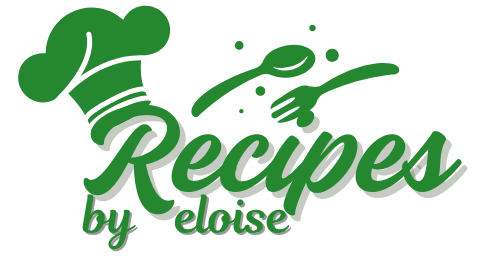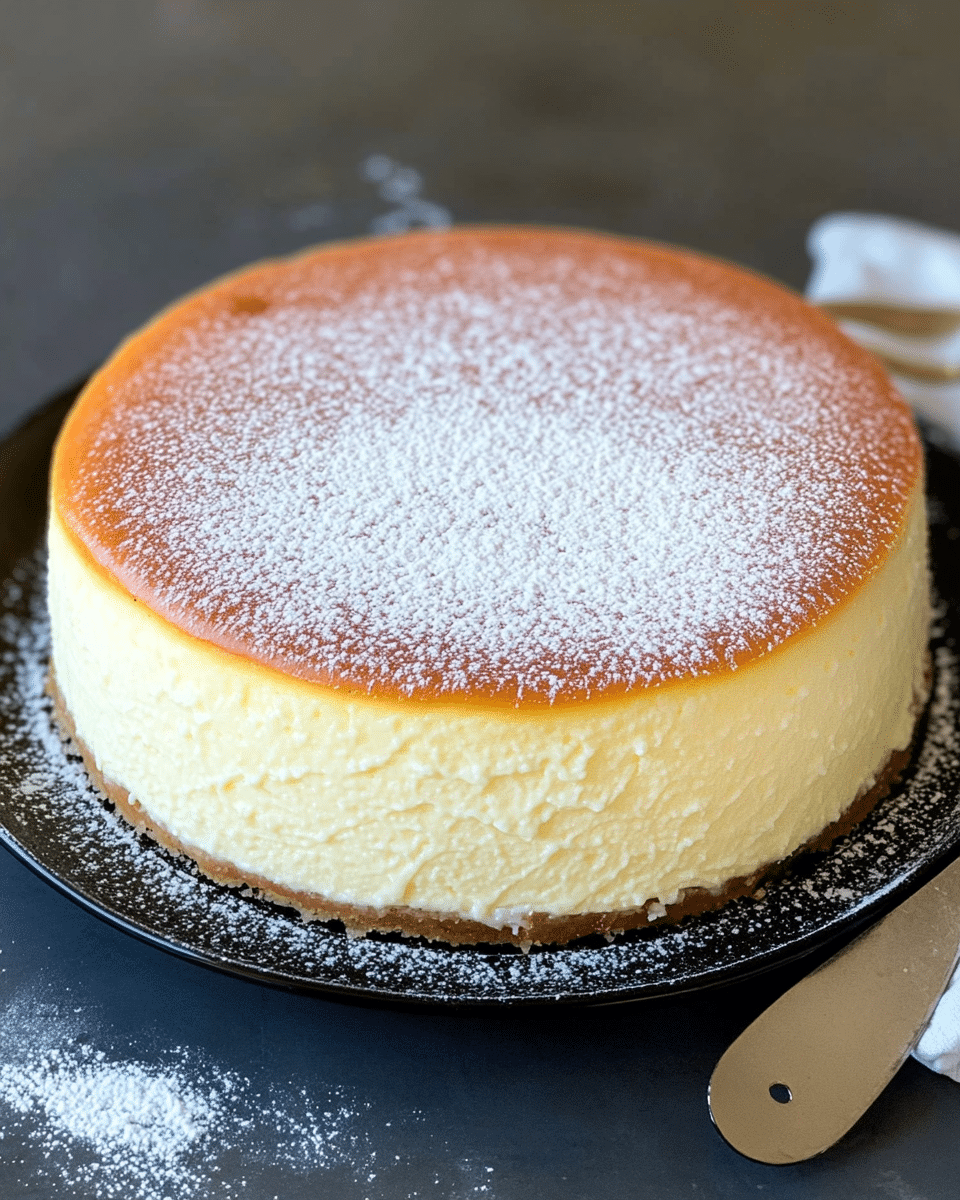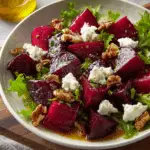Jiggly Japanese Cheesecake is a delicate and ethereal dessert that captivates with its soft, cloud-like texture and subtle sweetness. Unlike traditional dense cheesecakes, this version uses whipped egg whites and a gentle water bath baking method to create a light and bouncy cake that literally jiggles on the plate. Its elegant simplicity makes it a perfect choice for both casual teatime and special occasions.
The charm of this cheesecake lies not only in its texture but also in its appearance—its smooth, golden-brown top and softly puffed edges invite you to slice into a slice of airy bliss. Served dusted with powdered sugar or fresh berries, it offers a refined and delightful experience that’s as pleasing to the eye as it is to the palate. Whether you’re a seasoned baker or a dessert lover eager to try something new, this Japanese classic will quickly become a favorite.
Full recipe:
Ingredients:
-
250g cream cheese, softened
-
50g unsalted butter, softened
-
100ml whole milk
-
60g cake flour
-
20g cornstarch
-
6 large eggs, separated
-
140g granulated sugar
-
1 tsp lemon juice
-
1/4 tsp cream of tartar
-
Powdered sugar for dusting (optional)
Directions:
-
Preheat the oven to 320°F (160°C). Prepare a 7-inch round cake pan by greasing it and lining the bottom and sides with parchment paper.
-
In a heatproof bowl over simmering water, gently melt the cream cheese, butter, and milk together until smooth. Remove from heat and let cool slightly.
-
Sift the cake flour and cornstarch together. Gradually add to the cream cheese mixture, mixing until combined.
-
Add egg yolks one at a time to the batter, stirring well after each addition. Mix in the lemon juice.
-
In a separate large bowl, beat the egg whites with cream of tartar until foamy. Gradually add granulated sugar and continue beating until stiff peaks form.
-
Gently fold about one-third of the egg whites into the cream cheese batter to lighten it. Then carefully fold in the remaining egg whites until just combined, taking care not to deflate the mixture.
-
Pour the batter into the prepared cake pan. Tap the pan lightly to release any large air bubbles.
-
Place the cake pan into a larger baking dish. Pour hot water into the outer dish to create a water bath, filling about halfway up the sides of the cake pan.
-
Bake for 60-70 minutes or until the top is golden brown and a skewer inserted comes out clean. Turn off the oven and leave the cake inside with the door slightly ajar for 10 minutes to prevent collapse.
-
Remove the cake from the water bath and cool completely on a wire rack. Dust with powdered sugar before serving, if desired.
Prep Time: 20 minutes | Cooking Time: 70 minutes | Total Time: 1 hour 30 minutes
Kcal: 280 kcal per serving | Servings: 8
History and Origins
The Japanese cheesecake is believed to have been inspired by Western-style cheesecakes introduced to Japan in the early 20th century. However, Japanese bakers adapted the recipe to suit local palates, which often favor lighter and less sweet foods. The transformation led to the creation of this soufflé-like cheesecake, which blends traditional cheesecake ingredients with techniques borrowed from Japanese sponge cakes and soufflés.
One famous baker credited with popularizing the style is Fujiya, a Japanese confectionery company that introduced their version in the 1960s. Since then, the cake has become a staple in Japanese bakeries and cafes and has grown in popularity worldwide due to its unique texture and visual appeal.
What Makes It Different?
The main difference between Japanese cheesecake and its Western counterparts lies in its texture and preparation method. The traditional American or European cheesecakes typically rely on a dense cream cheese base mixed with eggs and sugar, often with a crust made from crushed cookies or graham crackers.
In contrast, the Japanese cheesecake incorporates whipped egg whites folded into the cream cheese mixture. This step aerates the batter, creating a much lighter and fluffier texture. The use of a water bath (bain-marie) during baking gently cooks the cake, preventing cracks and promoting even cooking without drying out the batter. This method also gives the cake its characteristic jiggle when gently shaken.
The result is a cake that is soft and moist with a delicate sweetness that is not overpowering. It has a smooth mouthfeel that is more sponge-like but still retains the creamy tanginess of cream cheese.
Texture and Flavor Profile
The texture of this cheesecake is often described as “fluffy,” “airy,” or “cotton-like.” When sliced, it almost trembles or jiggles on the plate, reminiscent of a soufflé or a very light mousse. This effect is not only visually impressive but also creates a delightful eating experience that contrasts with the denser, heavier cheesecakes many are accustomed to.
Flavor-wise, the cake is mild and creamy with a subtle tang from the cream cheese balanced by gentle sweetness. The addition of lemon juice or zest is common to add a hint of brightness that enhances the flavor without overwhelming the palate. Unlike many traditional cheesecakes, it does not have a crust, which keeps the focus entirely on the soft cake itself.
Techniques and Tips for Success
Making Jiggly Japanese Cheesecake requires some attention to detail and specific techniques to achieve its signature texture. The key steps include properly whipping egg whites, folding the batter gently, and baking in a water bath.
Whipping egg whites to stiff peaks is crucial, as this traps air that gives the cake its fluffiness. It’s important to ensure the mixing bowl and beaters are clean and free of any grease to allow the egg whites to whip properly. Adding a stabilizer like cream of tartar or lemon juice helps maintain the volume.
Folding the whipped egg whites into the batter must be done delicately. Vigorous mixing can deflate the air bubbles, leading to a denser cake. Using a spatula and folding in thirds, turning the bowl as you fold, helps keep the batter light and aerated.
The water bath helps regulate the temperature during baking, ensuring gentle and even cooking. This prevents the cake from cracking and drying out. Using parchment paper to line the pan also aids in easy removal and preserves the cake’s delicate structure.
Serving Suggestions
Jiggly Japanese Cheesecake is versatile and can be served in various ways. Its subtle flavor pairs beautifully with fresh fruits such as strawberries, blueberries, or raspberries, which add a burst of color and freshness. Dusting the top with powdered sugar adds a touch of elegance and a hint of extra sweetness.
For a more indulgent presentation, serve it with whipped cream, a drizzle of fruit compote, or a light glaze made from citrus or berry reductions. Its delicate texture makes it an ideal dessert for afternoon tea or as a light finish to a meal.
Because it is less sweet and heavy than traditional cheesecakes, it also works well with a cup of green tea, matcha latte, or even coffee, balancing richness with bitterness.
Nutritional Aspects
Compared to typical cheesecakes, the Japanese version is often lighter in calories due to the incorporation of whipped egg whites and the absence of a heavy crust. It typically contains fewer fats and sugars, which appeals to those who want a dessert that feels less indulgent but still satisfying.
That said, it is still a cheesecake at heart, so moderation is recommended. The cake provides protein from eggs and cream cheese and some calcium but should be enjoyed as part of a balanced diet.
Popularity and Cultural Impact
Jiggly Japanese Cheesecake has transcended borders, becoming a global sensation through social media, food blogs, and culinary shows. Its photogenic nature, especially its wobbling motion, has made it a favorite subject for food photography and videos.
In Japan, this cake is a popular gift item and often found in specialty bakeries. It symbolizes craftsmanship and the fusion of Western and Japanese baking traditions. Worldwide, many home bakers embrace it as a fun and rewarding baking challenge.
Its rising popularity has also inspired countless variations, including matcha-flavored versions, chocolate-infused ones, and even savory adaptations using cheese and herbs.
Conclusion
Jiggly Japanese Cheesecake stands out as a delightful dessert that offers something truly different from the usual cheesecake experience. Its airy texture, subtle sweetness, and creamy flavor make it an irresistible treat for anyone who appreciates elegant and light desserts. The baking techniques required not only produce a beautiful cake but also offer a rewarding culinary experience for home bakers.
Whether you are looking to impress guests, enjoy a unique dessert, or explore Japanese cuisine, this cheesecake delivers a perfect balance of taste and texture. Its delicate jiggle and melt-in-your-mouth softness are sure to charm anyone lucky enough to try it. Adding this recipe to your dessert repertoire is a wonderful way to bring a little bit of Japan’s refined baking culture into your kitchen.






